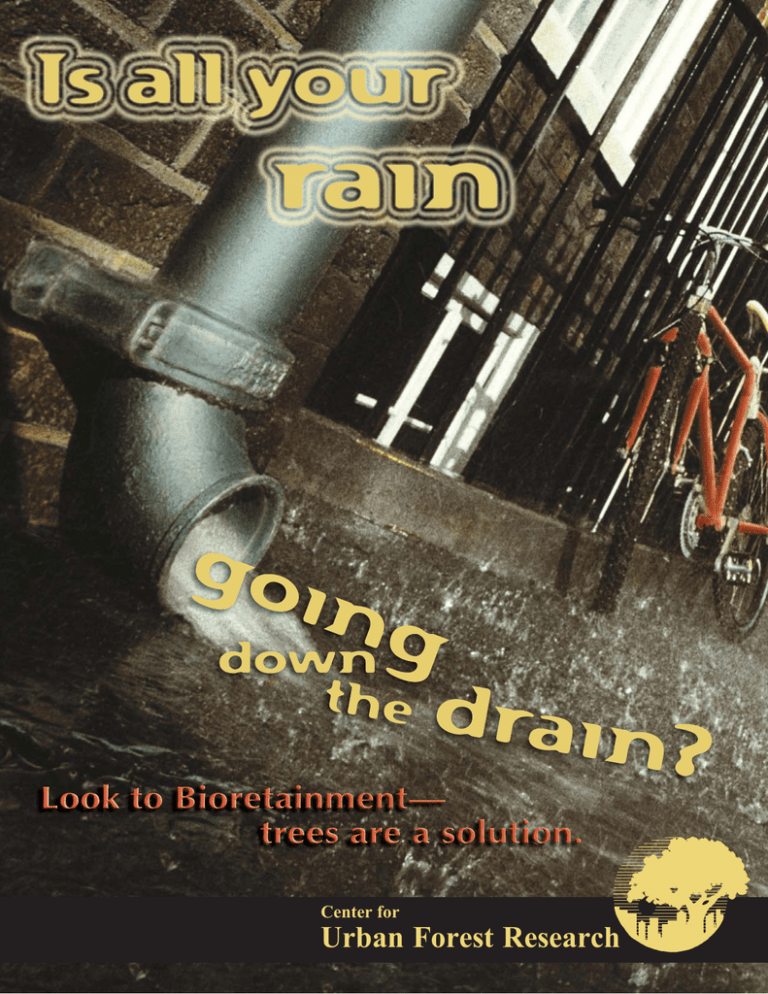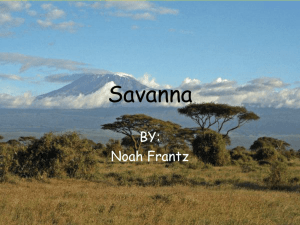Urban Forest Research Center for
advertisement

Center for Urban Forest Research How much rain can a tree retain? One tree reduces stormwater runoff by over 4,000 gallons per year.* Bioretainment —The New Technology Trees are the new technology to retain water What is Bioretainment? on site, some permanently, some temporarily, It is the storage of rainfall on leaves, branches and trunk bark. Following the rainfall event, the water is either evaporated directly to the atmosphere, absorbed by the canopy surfaces, or flows down to the ground surface. to slow the flow to waterways. Trees protect water and soil resources. Healthy trees can reduce the amount of runoff and pollutants in creeks, ponds and other receiving More trees community = equals = lower costs for stormwater control waters in three primary ways; • leaves, branch surfaces, and trunk bark intercept and store rainfall, thereby reducing runoff volumes and delaying the onset of peak flows; • root growth and decomposition increase the capacity and rate of soil infiltration by rainfall and reduce overland flow; • tree canopies reduce soil erosion by diminishing the impact of raindrops on barren surfaces. one that lasts only “ two hours.” water during a 1-inch rainfall event that lasts two days than one that lasts only two hours; 2) tree structure and leaf and bark surface area natural landscape is converted to impervious perature, relative humidity, net radiation and surfaces such as roads, parking lots, driveways wind speed control the length of time rainfall and buildings. Manmade drainage systems, is retained in storage. carries contaminants such as oil, metals or two days than same results because 1) trees retain more and storage of rainwater uniquely; and 3) tem- However, water quality suffers when runoff event that lasts weather. Not every event will produce the As we build our communities, considerable nities and into drainages and natural waterways. a 1-inch rainfall fall event, tree species and their structure, and differ by species and each one controls the flow accelerate water movement through commu- water during factors: character and magnitude of the rain- Urban Hydrology — The Problem such as sewers and storm drains, are used to “ Trees retain more Retainment of water is influenced by three pesticides into streams, wetlands, lakes, and marine waters. The Type of Tree is Important The mix of tree species and their size influence interception. In regions where most precipitation occurs in winter, evergreen trees play the most important role in interception. Trees with evergreen foliage contribute to greater interception than deciduous trees. Some Trees Retain Water On Site — conifers intercept more rainfall than similar Bioretainment sized deciduous trees. In climates with summer During a rainfall event, precipitation is either precipitation, deciduous trees make a substan- intercepted by leaves, branches, and the trunk, tial contribution to rainfall interception. or it falls directly through the tree to the Planting more trees and improving health of ground. Intercepted water is stored temporarily existing trees is an important strategy that will on leaf and bark surfaces. It eventually drips help reduce the volume of stormwater runoff. from leaf surfaces, flows down stem and trunk surfaces to the ground, or it evaporates. * One large deciduous tree in coastal southern California A typical community forest of 10,000 trees will retain approximately HOW TO 10 million gallons of rain water per year. Incorporate Bioretainment into the Stormwater Management Process • Select tree species with architectural features that maximize interception, such as large leaf surface area and rough surfaces that store water. • Plant trees in small groves where possible. • Plant low-water-use tree species where appropriate and natives that, once established, require little supplemental irrigation. In bioretention areas, be sure the species can adapt to standing and fluctuating water levels. • Increase the tree canopy within your community by planting more large-crowning trees. • Match trees to rainfall patterns so that they are in-leaf when precipitation is greatest. • Plant broadleaf evergreens where appropriate, and avoid shading south-facing windows in the winter to maximize solar heat gain. • Improve the maintenance of existing trees. • Plant more trees in appropriate areas such as parkways, boulevards, parking lots, traffic islands, swales, median strips, and residential “rain gardens.” This will aid the retention/detention and infiltration/ filtration processes. Urban Forests Produce More Benefits Through Water Quality Protection than Flood Control. Although trees reduce runoff, they may not be very effective for flood control. Floods usually occur during major storms, well after canopy storage is exceeded. However, by substantially reducing the amount of runoff during less extreme events, urban forests can protect water quality. Small storms, for which urban forest interception is greatest, are responsible for most annual pollutant loading. Infrequently occurring large storms usually produce the greatest flood damage, and although they may contain significant pollutant loads, their contribution to the annual average pollutant load is quite small. Also, because of the infrequency of large storms, receiving waters have relatively long periods of recovery between events. This summary is based on Dr. Xiao’s research published in the Journal of Arboriculture in 1998. Xiao, Q. F.; et. al. 1998. Rainfall interception by Sacramento’s urban forest. J. Arbor. 24(4): 235–244. For more information, refer to the following publications: Chang, G.; J. Parrish; and C. Souer. 1990. The first flush of runoff and its effect on control structure design. Environmental Resource Management Division. Department of Environmental and Conservation Services. City of Austin, Austin, TX. 36 pp. Claytor, R. A.; and T. R. Schueler. 1996. Design of stormwater filtering systems. The Center for Watershed Protection, Silver Spring, MD. McPherson, E. G.; 1998. Structure and sustainability of Sacramento’s urban forest. J. Arbor. 24(4): 174–190. McPherson, E. G.; et. al. 2000. Tree guidelines for coastal Southern California communities. Local Government Commission, Sacramento, CA. 97 p. McPherson, E. G.; et. al. 1999 Benefit-cost anlysis of Modesto’s municipal urban forest. J. Arbor. 25(5): 235–248. Xiao, Q. F.; et. al. 2000. Winter rainfall interception by two mature open-grown trees in Davis, California. Hydrol. Process. 14: 763–784. Xiao, Q. F.; et. al. 2000. A new approach to modeling tree rainfall interception. J. of Geophysical Research. 105(D23): 29, 173–29, 188. The United States Department of Agriculture (USDA) prohibits discrimination in all its programs and activities on the basis of race, color, national origin, gender, religion, age, disability, political beliefs, sexual orientation and marital or family status. (Not all prohibited bases apply to all programs.) Persons with disabilities who require alternative means for communication of program information (Braille, large print, audiotape, etc.) should contact USDA’s TARGET Center at: (202) 720-2600 (voice and TDD). To file a complaint of discrimination, write: USDA Director, Office of Civil Rights, Room 326W, Whitten Building, 14th and Independent Avenue, SW, Washington, DC 20250-9410, or call: (202) 720-5964 (voice or TDD). USDA is an equal opportunity provider and employer. August 2003 Center for Urban Forest Research Pacific Southwest Research Station, USDA Forest Service 1 Shields Avenue, Suite 1103 Davis, CA 95616-8587 (530) 752-7636 • Fax (530) 752-6634 http://cufr.ucdavis.edu/ What is the Value of Bioretainment? To estimate the value of bioretainment, we use stormwater management control costs based on minimum requirements for stormwater management in a particular region. For example: • In Western Washington, for a 10-acre, single-family residential development on permeable soils it costs approximately $0.02779/gal to treat and control flows stemming from a 24-hour storm. • In Fresno, the average cost for constructing and maintaining a typical detention/retention basin is $121,439/acre. With a 50 percent probability of filling 10 times in a 20-year period, the cost of detention/ retention is $0.0077/gallon. • In Los Angeles, it costs approximately $0.0183/gal to treat sanitary waste, and we assume a similar cost for stormwater. Trees manage stormwater runoff. They help reduce pollution and make waterways healthy for people and fish. To calculate benefits, we multiply the management cost by gallons of rainfall intercepted after the first 0.1 inch has fallen for each storm (24-hours without rain) during the year, depending on the region. Based on surface detention calculations, the first 0.1 inch of rainfall seldom results in runoff. Thus, interception is not a benefit until precipitation exceeds this amount. Check out our website at http://cufr.ucdavis.edu/ to see all the other benefits trees provide. NOTE: In looking for solutions to stormwater runoff it is important to consider an integrated approach that uses other water conservation, water retention, flood management, and pollution control strategies. Community solutions include but are not limited to porous pavement, vegetated swales and filter strips, recharge areas under parking lots, holding tanks and cisterns under playfields, surface area holding ponds, turf grass filters, and riparian retention and treatment areas. research that demonstrates new ways in which trees add value to your community, converting results into financial terms to assist you in stimulating more investment in trees. We conduct




